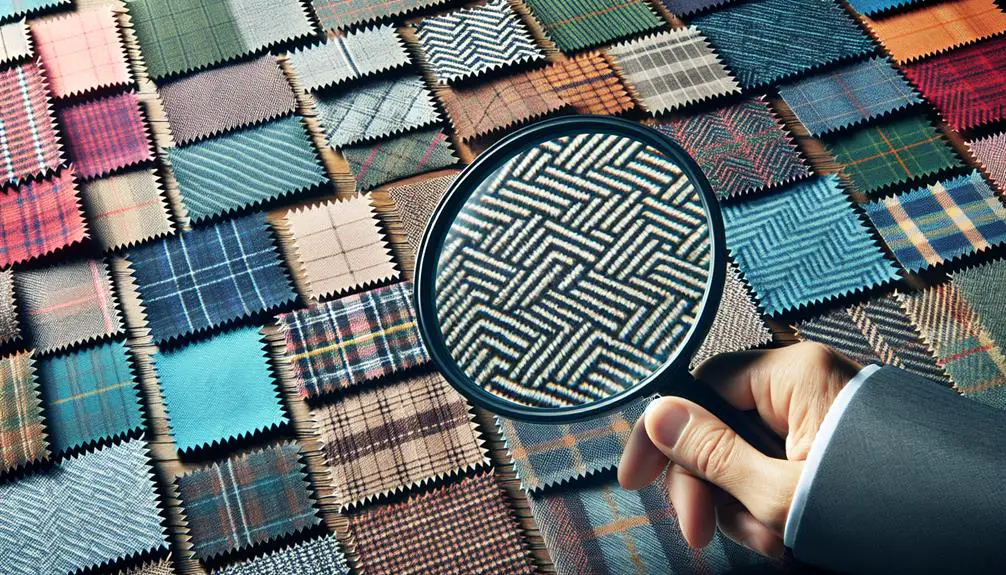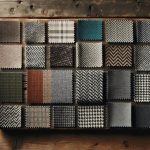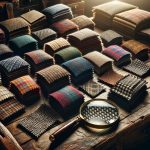I've always been a fan of tweed, but picking the best type can be a bit of a puzzle. Harris Tweed gets a lot of praise for its quality and traditional appeal, and honestly, it's hard to argue with that. It's warm, durable, and has that classic look that never seems to go out of style. But then, there's Donegal Tweed with its unique speckles and vibrant colors, and it's pretty tempting too. Each type has its own charm and uses, but I'm curious to hear what others think. What's your go-to tweed and why does it stand out to you?
Table of Contents
Key Takeaways
- Harris Tweed is legally protected for authenticity and is renowned for its durability and quality.
- Donegal tweed is celebrated for its unique speckled patterns, adding visual texture.
- Herringbone and Salt & Pepper are popular patterns offering classic visual appeal.
- Shetland tweed is known for its subtle charm and lightweight comfort.
- Japanese-designed tweed blends traditional aesthetics with modern fashion trends.
Origins and History of Tweed
Tweed's story begins on the misty islands of Scotland, where local weavers crafted the durable fabric to withstand harsh weather. These artisans, skilled in their craft, developed what we now recognize as tweed, a term that evolved from a misreading of 'tweel', the Scots word for twill. This historical mix-up gave us the name that stuck.
As I dove deeper into tweed's past, I learned that its development wasn't just about creating a sturdy textile. There were significant innovations along the way. Historically, tweed was handwoven, which added unique characteristics to each piece. This personal touch is something that modern machinery can't fully replicate, though it tries.
The fabric's colors and patterns were inspired by the local landscape, allowing wearers to blend into the Scottish terrain. This important aspect was essential for hunters and gamekeepers back in the day.
Understanding tweed terminology helps in appreciating its rich history. Terms like 'herringbone' and 'check' aren't just patterns but stories woven into the fabric, each with a specific origin and purpose. These innovations and terms enrich my appreciation of tweed, showing it's more than just a fabric but a craft perfected over centuries.
Understanding Different Tweed Types
Now, let's look at the different types of tweed.
We'll start by exploring where each variety comes from and how they're made.
Then, we'll check out the most popular textures and what makes them unique.
Origin of Tweed Varieties
Let's explore the origins of different tweed types, each with its unique history and characteristics. Tweed originated from Scotland and Ireland, where local materials and climate shaped its development. Tweed innovations have continuously evolved, influenced by both tradition and new weaving techniques. Global tweed influences have played an essential role too, with fashion designers and international markets adapting and embracing tweed's versatility.
For instance, Harris Tweed from Scotland is legally protected, its methods handed down through generations. Elsewhere, Japanese designers have experimented with tweed, blending traditional patterns with modern aesthetics. Each type of tweed captures a cultural narrative, enriched by the locale's history and the global exchange of ideas and styles in the textile industry.
Popular Tweed Textures
Exploring popular tweed textures reveals a variety of patterns and weaves that each have their own unique appeal. When you dive deep, you notice that each texture not only stands out due to its intricate weaving but also through its distinct finish and burst of colors.
Here's what you need to know:
- Herringbone: Known for its broken zigzag pattern, this texture offers a classic appeal that's versatile in both formal and casual wear. Its subtle color variations enhance its sophistication.
- Houndstooth: This is characterized by its abstract four-pointed shapes, usually in two colors, creating a bold, dynamic look.
- Barleycorn: This texture shows a pebbled finish, with richer, deeper color variations, giving it a robust, tactile feel.
These tweed finishes and color variations bring life to any wardrobe, blending tradition with personal style.
Characteristics of Harris Tweed
Now, let's talk about what makes Harris Tweed stand out.
I'll cover its guaranteed authenticity, how tough it is, and how it's made.
Each of these aspects plays a big role in why Harris Tweed is so special.
Harris Tweed Authenticity
Every piece of Harris Tweed stands out with its unique stamp of authenticity, ensuring it's made from pure virgin wool and handwoven by islanders at their homes in the Outer Hebrides of Scotland. This isn't just about tradition; it's certified quality.
- Certification Marks: Each fabric bears the Orb Mark. It's not just a label; it's a legal promise of the tweed's origin and craftsmanship.
- Legal Protections: Harris Tweed is protected under the Harris Tweed Act of 1993. This law rigorously maintains the standards of its production.
- Geographical Indications: Only tweed made in this specific region can be called Harris Tweed. It's a geographical indicator, like Champagne for sparkling wine.
This system isn't just about maintaining quality; it's about preserving a legacy.
Durability of Harris Tweed
Harris Tweed's remarkable durability makes it a top choice for long-lasting apparel. I've found that its toughness is unmatched, really. You're looking at a fabric that can handle rough wear and still look classy. The secret? It's all in the weave and the wool. This tweed is tough, no doubt about it.
Thanks to Tweed innovation, the fabric has evolved. Modern techniques make Harris Tweed even more durable without sacrificing its classic appeal. And let's talk about Tweed recycling. It's a game-changer. Old tweed garments can be repurposed, reducing waste and promoting sustainability. So, not only does it last ages, but it also supports eco-friendly practices. That's a win-win in my book.
Harris Tweed Production Process
Let's explore how they create Harris Tweed, emphasizing its unique characteristics. The entire process relies heavily on traditional weaving techniques and the skilled hands of local artisans. These craftsmen make sure that each piece of tweed stands out with its distinct texture and robust quality.
Here's what sets Harris Tweed apart:
- Local Artisans: The fabric is handwoven by artisans in the Outer Hebrides, keeping the craft alive and authentic.
- Weaving Techniques: They use time-honored methods which give Harris Tweed its famous durability and intricate patterns.
- Quality Control: Every single tweed is inspected and certified, guaranteeing excellent quality.
This meticulous attention to detail is what truly defines Harris Tweed, making it a masterpiece of fabric craftsmanship.
Exploring Donegal Tweed Varieties
I'll now immerse myself in the colorful world of Donegal tweed varieties. Donegal tweed, known for its unique speckled patterns, offers a robust palette for fashion enthusiasts and designers alike. Each piece narrates a story, deeply rooted in Irish tradition, yet perfect for modern sustainability goals.
Exploring Donegal patterns, I've noticed that each design doesn't just aim to captivate; it aims for minimal environmental impact. The makers use local wool, reducing transportation emissions and bolstering local economies. This approach not only supports tweed sustainability but also preserves a way of life.
Here's a quick breakdown of some popular Donegal tweed varieties:
| Type | Characteristics | Uses |
|---|---|---|
| Herringbone | V-shaped weaving pattern, classic | Jackets, Skirts |
| Salt & Pepper | Small, contrasting flecks of color | Caps, Blazers |
| Checked | Crossed horizontal and vertical bands | Coats, Home Decor |
| Plain Twill | Simple and elegant, less textured | Trousers, Upholstery |
Each type offers something special. For instance, Herringbone brings a timeless elegance, while Salt & Pepper adds a playful yet sophisticated touch to any piece. Opting for Donegal tweed means choosing a fabric that lasts and respects the planet. It's a smart choice for those who care about both style and substance.
The Appeal of Shetland Tweed
While Donegal tweed boasts vibrant patterns, Shetland tweed captivates with its subtle charm and remarkable durability. I've found that its unique qualities stem from the distinctive Shetland sheep breeds, which are native to Scotland. These sheep provide the fine, soft wool that's essential for crafting Shetland tweed.
Here's why Shetland tweed stands out:
- Resilience: The tight weave and robust nature of this fabric make it a go-to for garments meant to withstand harsh weather.
- Comfort: Despite its durability, it's surprisingly lightweight and comfortable, ideal for daily wear.
- Aesthetic Versatility: The tweed color variations range from muted earth tones to richer, deeper shades, seamlessly blending with both modern and traditional styles.
I'm particularly impressed by how these attributes cater to a discerning audience. The tweed's ability to balance performance with aesthetics is unmatched. It's not just about looking good; it's about wearing something that lasts and performs. The more I explore Shetland tweed, the more I appreciate the craftsmanship behind it, driven by centuries of tradition and the unique characteristics of the Shetland sheep breeds. This tweed isn't just fabric; it's a heritage woven with expertise.
How Tweed Is Manufactured
Understanding how tweed is made reveals the skill and tradition behind this beloved fabric. The process starts with raw wool, often from local sheep, which is then dyed using various tweed coloring methods. These methods range from natural dyes to more modern chemical ones, each affecting the environmental impact differently.
Here's a quick overview in a table format:
| Step | Details |
|---|---|
| Wool Gathering | Sourced locally, promoting sustainability |
| Dyeing | Uses both natural and synthetic methods |
| Weaving | Handwoven on looms, preserving tradition |
After dyeing, the wool is spun into yarn. This part is crucial because how tightly the yarn is spun can affect the texture of the tweed. Next comes the weaving, which is traditionally done on treadle-powered looms. This method not only uses less energy but also highlights the craftsmanship involved.
Tweed in Fashion Today
Tweed's not just for old-school academics; it's rocking the fashion world today, from runways to street style. Designers are embracing tweed, transforming it into something fresh and exciting. It's no longer just about the classic jackets; we're seeing an explosion of modern tweed styles that are bold and innovative.
Take a look at how tweed is making its mark:
- High Fashion Reinvention: Top designers are incorporating tweed into their collections in unexpected ways. Think tweed combined with metallic threads or used in offbeat garment cuts. It's not just about tradition; it's about pushing boundaries.
- Streetwear Integration: Tweed is popping up in streetwear, mixed with casual, everyday items. A tweed backpack or a pair of tweed sneakers can add a touch of class to any casual outfit. It's about making tweed accessible and wearable for everyone.
- Accessorizing with Tweed: It's not just clothing; tweed accessories are everywhere. From hats and bags to belts and shoes, these pieces are perfect for adding a sophisticated twist to your ensemble. They bridge the gap between old-school charm and contemporary chic.
Caring for Your Tweed
To maintain the quality of your tweed, it's important to care for it correctly. Let's explore the best tweed cleaning methods and storage solutions to make sure your garments stay in excellent condition.
First off, avoid washing tweed frequently. This fabric loves minimal water exposure. When it's time for a clean, opt for professional dry cleaning. They know how to handle the delicate fibers without causing damage. If you've got a small stain, try spot cleaning with a mild detergent and cold water. Gently dab, don't rub, to preserve the fabric's integrity.
Now, let's discuss storage. Good tweed storage solutions are essential. Always store your tweed in a cool, dry place. Humidity is the enemy here! Use padded hangers to maintain the shape of jackets and coats. Avoid plastic covers; opt for a breathable garment bag instead to prevent any moisture buildup.
For long-term storage, consider using acid-free tissue paper to line the folds of the tweed. This prevents creasing and helps preserve the fabric's natural shape. Keep moths away by adding cedar balls or lavender sachets, which are excellent natural repellents.
Caring for your tweed correctly means you'll enjoy its beauty and durability for years. Simple steps, significant returns!
Tweed for Different Seasons
I often change up my tweed choices as the seasons shift to stay comfortable and stylish. Let's explore how different tweeds work for various seasons, focusing on summer and winter.
In summer, tweed isn't just about the traditional heavy weaves you might imagine. Summer tweed uses are all about lightweight, breathable fabrics. They're perfect for keeping things cool but still looking sharp. You'd want a fabric that lets you move freely without overheating.
Winter, on the other hand, requires something sturdier. Winter tweed insulation is important. The dense, thick weaves provide excellent warmth, acting like a shield against the biting cold. It's about staying cozy while maintaining that classic, rugged elegance tweed is known for.
Here's a quick breakdown:
- Summer Tweed: Opt for lighter, airier weaves. Think comfort and breathability.
- Winter Tweed: Choose heavier, denser fabrics for warmth.
- Transitional Tweed: Mid-weight tweed is versatile for spring and autumn, bridging the gap nicely.
Understanding these choices helps you maximize the utility and style of your wardrobe year-round. Remember, the right tweed not only suits the weather but also enhances your style quotient significantly.
Choosing the Right Tweed
Choosing the right tweed depends on your personal style and the occasion you're dressing for. When you're looking at tweed colors, think about where you'll be wearing it. Darker hues like deep greens, browns, and blues are versatile for formal events and office wear. For a more casual or standout look, lighter shades or even vibrant checks can really make an impact.
Now, let's talk about tweed patterns. The beauty of tweed is in its variety. You've got herringbones, checks, and plain weaves. If you're new to tweed, a classic herringbone in a neutral color is a safe and stylish choice. It's understated yet sophisticated. For those who want to show off a bit more personality, plaid or checked tweed can be a bold choice that still holds on to that classic elegance.
Frequently Asked Questions
Can Tweed Be Recycled or Upcycled Effectively?
Yes, tweed can be recycled or upcycled effectively. I've seen fantastic tweed repurposing in sustainability practices, turning old jackets into bags or cushions. It's a creative way to reduce waste and value craftsmanship.
Are There Vegan Alternatives to Traditional Tweed?
Yes, there are vegan alternatives to traditional tweed! Plant-based tweed options exist, focusing on sustainable production. They're great for those looking to keep their fashion choices both stylish and ethically sound.
How Does Tweed Impact the Environment?
Tweed production can be pretty rough on the environment, especially considering the water usage. It's something I'm trying to learn more about to make better choices when I'm shopping for clothes.
Is Tweed Considered a Luxury Fabric?
Yes, tweed is often seen as a luxury fabric. It's rooted in rich history and requires careful maintenance. I love its timeless appeal and unique texture, making it perfect for upscale garments.
What Are the Fire-Resistant Properties of Tweed?
I've looked into tweed's fire-resistant properties. Its composition isn't naturally flame-retardant, but burn testing methods reveal that treatments can enhance its resistance. It's intricate but essential for ensuring safety and durability.
- Tetron Fabric for Marine Applications: Durability and Use Cases - June 18, 2025
- Tetron Fabric for Outdoor Furniture: Weather Resistance and Care - June 18, 2025
- Tetron Fabric for Wall Coverings: Style and Application Tips - June 18, 2025







